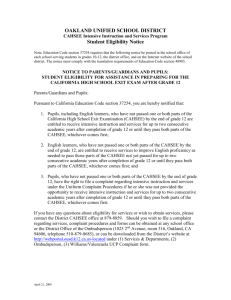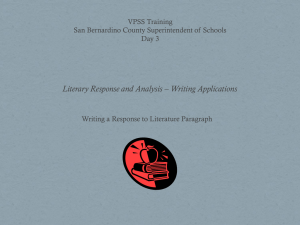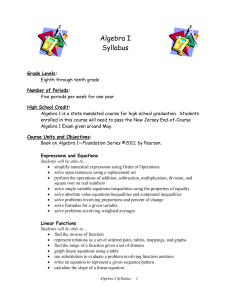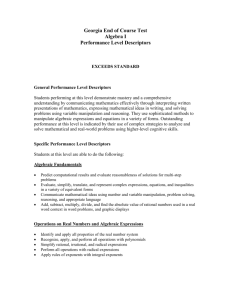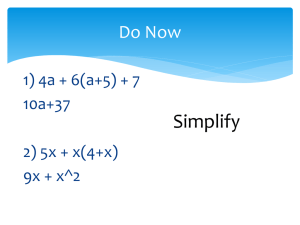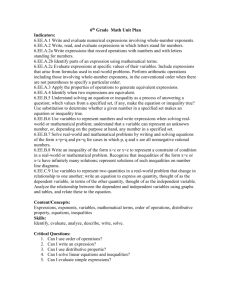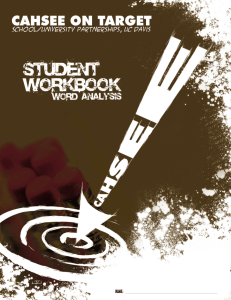CAHSEE Math Standards
advertisement
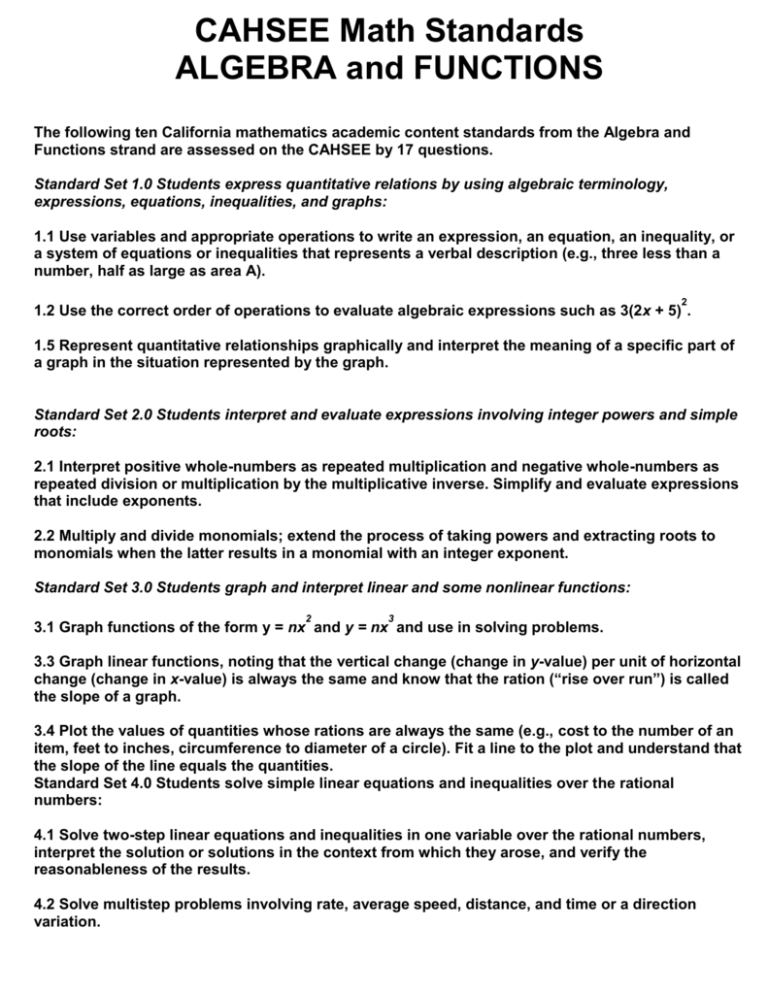
CAHSEE Math Standards ALGEBRA and FUNCTIONS The following ten California mathematics academic content standards from the Algebra and Functions strand are assessed on the CAHSEE by 17 questions. Standard Set 1.0 Students express quantitative relations by using algebraic terminology, expressions, equations, inequalities, and graphs: 1.1 Use variables and appropriate operations to write an expression, an equation, an inequality, or a system of equations or inequalities that represents a verbal description (e.g., three less than a number, half as large as area A). 2 1.2 Use the correct order of operations to evaluate algebraic expressions such as 3(2x + 5) . 1.5 Represent quantitative relationships graphically and interpret the meaning of a specific part of a graph in the situation represented by the graph. Standard Set 2.0 Students interpret and evaluate expressions involving integer powers and simple roots: 2.1 Interpret positive whole-numbers as repeated multiplication and negative whole-numbers as repeated division or multiplication by the multiplicative inverse. Simplify and evaluate expressions that include exponents. 2.2 Multiply and divide monomials; extend the process of taking powers and extracting roots to monomials when the latter results in a monomial with an integer exponent. Standard Set 3.0 Students graph and interpret linear and some nonlinear functions: 2 3 3.1 Graph functions of the form y = nx and y = nx and use in solving problems. 3.3 Graph linear functions, noting that the vertical change (change in y-value) per unit of horizontal change (change in x-value) is always the same and know that the ration (“rise over run”) is called the slope of a graph. 3.4 Plot the values of quantities whose rations are always the same (e.g., cost to the number of an item, feet to inches, circumference to diameter of a circle). Fit a line to the plot and understand that the slope of the line equals the quantities. Standard Set 4.0 Students solve simple linear equations and inequalities over the rational numbers: 4.1 Solve two-step linear equations and inequalities in one variable over the rational numbers, interpret the solution or solutions in the context from which they arose, and verify the reasonableness of the results. 4.2 Solve multistep problems involving rate, average speed, distance, and time or a direction variation. CAHSEE Math Standards NUMBER SENSE The following ten California mathematics academic content standards from the Number Sense strand are assessed on the CAHSEE by 14 test questions. Standard Set 1.0 Students know the properties of, and compute with, rational numbers expressed in a variety of forms: 1.1 Read, write, and compare rational numbers in scientific notation (positive and negative powers of 10) with approximate numbers using scientific notation. 1.2 Add, subtract, multiply, and divide rational numbers (integers, fractions, and terminating decimals) and take positive rational numbers to whole-number powers. 1.3 Convert fractions to decimals and percents and use these representations in estimations, computations, and applications. 1.6 Calculate the percentage of increases and decreases of a quantity. 1.7 Solve problems that involve discounts, markups, commissions, and profit, and compute simple and compound interest. Standard Set 2.0 Students use exponents, powers, and roots, and use exponents in working with fractions: 2.1 Understand negative whole-number exponents. Multiply and divide expressions involving exponents with a common base. 2.2 Add and subtract fractions by using factoring to find common denominators. 2.3 Multiply, divide, and simplify rational numbers by using exponent rules. 2.4 Use the inverse relationship between raising to a power and extracting the root of a perfect square integer; for an integer that is not square, determine without a calculator the two integers between which its square root lies and explain why. 2.5 Understand the meaning of the absolute value of a number; interpret the absolute value as the distance of the number from zero on a number line; and determine the absolute value of real numbers. CAHSEE Math Standards MEASUREMENT AND GEOMETRY The following ten California mathematics academic content standards from the Measurement and Geometry strand are assessed on the CAHSEE by 17 test questions. Standard Set 1.0 Students choose appropriate units of measure and use ratios to convert within and between measurement systems to solve problems: 1.1 Compare weights, capacities, geometric measures, times, and temperatures within and between measurement systems (e.g., miles per hour and feet per second, cubic inches to cubi centimeters). 1.2 Construct and read drawings and models made to scale. 1.3 Use measures expressed as rates (e.g., speed, density) and measures expressed as products (e.g., person-days) to solve problems; check the units of the solutions; and use dimensional analysis to check the reasonableness of the answer. Standard Set 2.0 Students compute the perimeter, area, and volume of common geometric objects and use the results to find measures of less common objects. They know how perimeter, area and volume are affected by changes of scale: 2.1 Use formulas routinely for finding the perimeter and area of basic two-dimensional figures and the surface area and volume of basic three-dimensional figures, including rectangles, parallelograms, trapezoids, squares, triangles, circles, prisms, and cylinders. 2.2 Estimate and compute the area of more complex or irregular two- and threedimensional figures by breaking the figures down into more basic geometric objects. 2.3 Compute the length of the perimeter, the surface area of the faces, and the volume of a three-dimensional object built from rectangular solids. Understand that when the lengths of all dimensions are multiplied by a scale factor, the surface area is multiplied by the square of the scale factor and volume is multiplied by the cube of the scale factor. 2.4 Relate the changes in measurement with a change of scale to the units used (e.g., square inches, cubic feet) and to conversions between units (1 square foot = 144 2 2 square inches or [1 ft ] = [144 in ], 1 cubic inch is approximately 16.38 cubic 3 3 centimeters or [1 in ] = [16.38 cm ] CAHSEE Math Standards STATISTICS, DATA ANALYSIS, AND PROBABILITY The following seven California mathematics academic content standards from the Statistics, Data Analysis and Probability strand are assessed on the CAHSEE by 12 test questions. Standard Set 1.0 Students compute and analyze statistical measurements for data sets: 1.1 Compute the range, mean, median, and mode of data sets.* Standard Set 2.0 Students use data samples of a population and describe the characteristics and limitations of the samples. 2.5 Identify claims based on statistical data and, in simple cases, evaluate the validity of the claims. Standard Set 3.0 Students determine theoretical and experimental probabilities and use these to make predictions about events: 3.1 Represent all possible outcomes for compound events in an organized way (e.g., tables, grids, tree diagrams) and express the theoretical probability of each outcome. 3.3 Represent probabilities as ratios, proportions, decimals between 0 and 1, and percentages between 0 and 100 and verify that the probabilities computed are reasonable; know that if is the probability of an event, 1 – P is the probability of an event not occurring. Understand the difference between independent and dependent events. Standard Set 1.0 Students collect, organize, and represent data sets that have one or more variables and identify relationships among variables within a data set by hand and through the use of an electronic spreadsheet software program: 1.1 Know various forms of display for data sets, use the forms to display a single set of data or to compare two sets of data. 1.2 Represent two numerical variables on a scatterplot and informally describe how the data points are distributed and any apparent relationship that exists between the two variables (e.g., between time spent on homework and grade level). CAHSEE Math Standards ALGEBRA I The following ten California mathematics academic content standards from the Algebra I strand are assessed on the CAHSEE by 12 test questions. Standard Set 2.0 Students understand and use such operations as taking the opposite, finding the reciprocal, and taking a root, and raising to a fractional power. They understand and use the rules of exponents. Standard Set 3.0 Students solve equations and inequalities involving absolute values. Standard Set 4.0 Students simplify expressions before solving linear equations and inequalities in one variable, such as 3(2x-5) + 4(x-2) = 12. Standard Set 5.0 Students solve multistep problems, including word problems, involving linear equations and linear inequalities in one variable and provide justification for each step. Standard Set 6.0 Students graph a linear equation and compute the x- and yintercepts (e.g., graph 2x + 6y = 4). They are also able to sketch the region defined. Standard Set 7.0 Students verify that a point lies on a line, given an equation of the line. Students are able to derive linear equations. Standard Set 8.0 Students understand the concepts of parallel lines and perpendicular lines and how their slopes are related. Students are able to determine perpendicular and parallel lines. Standard Set 9.0 Students solve a system of two linear equations in two variables algebraically and are able to interpret the answer graphically. Students are able to solve a system of two linear inequalities in two variables and to sketch the solution sets. Standard Set 10.0 Students add, subtract, multiply, and divide monomials and polynomials. Students solve multistep problems, including word problems, by using these techniques. Standard Set 15.0 Students apply algebraic techniques to solve rate problems, work problems, and percent mixture problems. CAHSEE Math Standards MATHEMATICAL REASONING The following six California mathematics academic content standards from the Mathematical Reasoning strand are assessed on the CAHSEE by 8 test questions. Standard Set 1.0 Students make decisions about how to approach problems: 1.1 Analyze problems by identifying relationships, distinguishing relevant from irrelevant information, identifying missing information, sequencing and prioritizing information, and observing patterns. 1.2 Formulate and justify mathematical conjectures based on a general description of the mathematical question or problem posed. Standard Set 2.0 Students use strategies, skills, and concepts in finding solutions: 2.1 Use estimation to verify the reasonableness of calculated results. 2.3 Estimate unknown quantities graphically and solve for them by using logical reasoning and arithmetic and algebraic techniques. 2.4 Make and test conjectures by using both inductive and deductive reasoning. Standard Set 3.0 Students determine a solution is complete and move beyond a particular problem by generalizing to other situations: 3.3 Develop generalizations of the results obtained and the strategies used and apply them to new problem situations.


